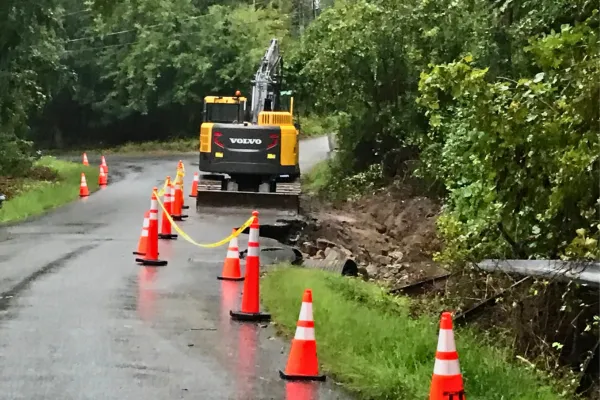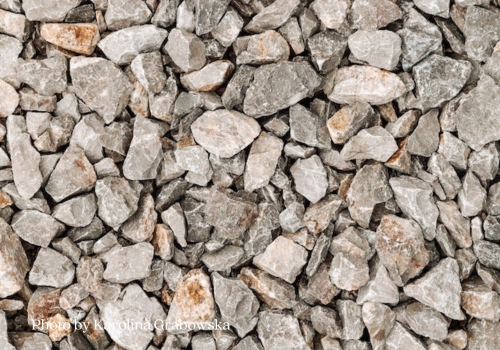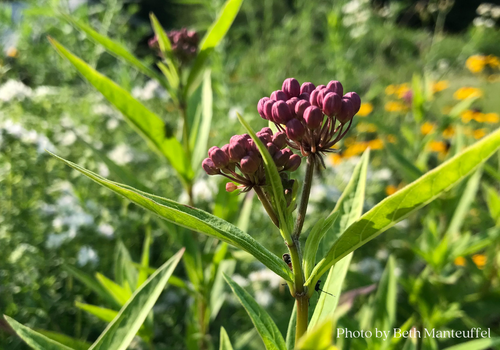Note: You may filter by category below. To use search feature for all categories return to main blog page here.

Rainwater Collection and Flood Prevention for Our Homes and Communities
Some of the links below are affiliate links. As an Amazon Associate I earn from qualifying purchases.
Introduction
Have you considered rainwater collection strategies and flood prevention solutions to create a more resilient property and protect your assets? This has been top of mind lately, as we’ve had heavy downpours here in the northeast in recent weeks. I was watching video footage of impassible roads and flooded highways, and my rain gauge was overflowing! According to ctpublic.org, during a storm here in Connecticut “nearly 10 inches of rain fell in six hours…which weather officials described as a 200-year event.” The image above is one of the washed-out bridge crossings connected to my road.
Managing stormwater for our private and public spaces is becoming increasingly important for both environmental and economic reasons, and of course for life safety reasons. In this blog post, we'll explore strategies to minimize stormwater damage, prevent flooding, and use rainwater effectively. By the time you finish reading, you'll be well-equipped to make the most of every raindrop that falls on your property, while protecting it from the potential damage of heavy rain events.
The Importance of Rainwater Management

Before we dig into stormwater control measures and rainwater collection, let’s look at some reasons why stormwater management is crucial:
Conservation:
Every drop of water saved is essential. Water sustains life here on earth and is a precious resource. Rainwater harvesting reduces the burden on municipal water supplies and preserves local water resources. If your water is supplied by a well, relying solely on that source can put stress on the aquifer it taps into. Rainwater harvesting can complement your municipal or well water supply to provide resiliency during times of drought or loss of supply, as a backup water source on site.
Cost Savings:
By using harvested rainwater for non-potable purposes like irrigation you can lower your municipal water bills, or the electricity usage from a well pump. As an effort to prevent localized flooding, stormwater management can help protect your assets.
Environmental Impact:
When stormwater runoff carries pollutants or excess nutrients into ecologically sensitive areas, it can lead to habitat degradation and harm to aquatic life. Flooding and heavy rain can pose a risk to these areas. Stormwater management practices, such as rain gardens and vegetative buffers, act as natural filters, removing pollutants and improving water quality before it enters vulnerable ecosystems.
Rainwater Measurement

When we have data we can make more informed decisions about strategies to implement. There are a variety of rain gauges available, each designed to suit specific needs. They range from the traditional manual rain gauges to the more high-tech automatic and wireless versions.
Both standard and tipping-bucket rain gauges tend to be low-cost options. Other options that weigh precipitation, or use acoustic, optical, or radar technology tend to be more costly and are often used for research or specialized applications.
Low-Cost Rain Gauge Options
A standard rain gauge is a simple funnel that collects rainwater. Standard rain gauges provide accurate measurements but require manual reading and maintenance. Linked here is the simple rain gauge I chose to install at my home, pictured above. Aim to locate the gauge in a more open area and avoid placement near objects that can obstruct collection.
Smart Weather Stations with Rain Gauges
I’ve been wanting to invest in a smart weather station that includes a rain gauge. Some highly reviewed gauges that are common for homeowner use include the following:
AcuRite Atlas Weather Station: The AcuRite Atlas series offers a comprehensive weather station, which includes a rain gauge. It has received positive feedback for its data accuracy and durability.
Netatmo Weather Station with Rain Gauge: Netatmo's weather station is known for having a user-friendly app, phone compatibility, and accurate rainfall measurements.
Ambient Weather Smart Weather Station: Similar to the previous models, the Ambient Smart Weather Station is a popular choice for homeowners and weather enthusiasts, offering a range of sensors to monitor various weather conditions, including rainfall.
Rain gauge selection depends on factors like accuracy requirements, ease of maintenance, and the specific purpose of the rainfall data collection. Accurate rainfall measurement is important for effective water resource management, flood prediction, and climate monitoring.
Community Measurement
During a visit to Mount Washington, I learned of a program called The Community Collaborative Rain, Hail and Snow Network (CoCoRaHS), which is “a nonprofit, community-based, network of volunteers who measure and report rain, hail and snow in their backyards.” If you’d like to report your precipitation measurements, you can help in the data mapping project. To get involved visit cocorahs.org.
Effective Rainwater Management Strategies
Now that we've established the importance of rainwater management and how to measure rainwater, let's explore some strategies to implement for our private and public spaces:
1. Rain Barrels and Cisterns

Rain barrels and cisterns are excellent options for capturing rainwater from your roof. Be aware that some states or local regions may prohibit rainwater collection to avoid negative impacts on groundwater levels. Where collection is allowed, here's how to make the most of these systems:
Placement: Position your rain barrels or cisterns strategically beneath downspouts to capture rainwater efficiently.
Filtration: Install filters to prevent debris from entering the barrels or cisterns, ensuring cleaner water for later use.
Overflow Control: Include an overflow system to redirect excess water away from your foundation, preventing flooding.
2. Permeable Surfaces

When choosing to install a driveway, walkway or patio, consider permeable materials like gravel or permeable pavers. This allows rainwater to infiltrate the ground rather than running off into storm drains. It's a simple yet effective way to reduce runoff. Materials like concrete have high embodied carbon and are considered an impermeable surface, which can contribute to localized flooding and overloading of stormwater drainage systems.
Permeable pavers typically have a lower embodied carbon footprint compared to traditional concrete or asphalt surfaces because they use less material and require less energy during production. Permeable pavers are often made from materials like concrete, but they are designed with voids or openings that allow water to pass through, reducing the overall quantity of material needed. Some permeable pavers are produced using recycled materials, further lowering their carbon footprint.
3. Rain Gardens

Rain gardens are beautiful and functional. By planting native, water-absorbing vegetation in low-lying areas of your property, you create a natural filtration system that captures and purifies rainwater. Rain gardens can also help reduce erosion and provide ecological benefits. Rose Milkweed (asclepias incarnata), also known as swamp or marsh milkweed, is pictured above in my Certified Wildlife Garden®. It is a native perennial that loves moisture and is a great addition to a rain garden throughout its native range. This perennial is a larval host plant to monarch butterflies, allowing these species to sustain the next generation.
4. Swales and Bioswales
A swale is a shallow, vegetated channel or depression designed to redirect and slow down stormwater, preventing runoff and allowing water to infiltrate the ground while also managing and filtering it. Swales are more functional in managing stormwater flow, while rain water gardens primarily focus on aesthetics and habitat creation.
Bioswales are a specific type of swale designed with specific soil and a variety of native plants to effectively capture, treat, and filter stormwater runoff, typically featuring a focus on improving water quality and supporting plant growth.
5. Rainwater Diversion
Direct stormwater from your downspouts to landscaped areas that need watering to conserve water. When locating downspouts at our home after our basement flooded we were advised to extend them 15 feet away from the foundation. Another strategy I’ve seen in my LEED training is where downspouts flow into a raised planter bed.
6. Retention Ponds or Detention Basins

Stormwater solutions such as retention ponds or detention basins can help mitigate flooding, by temporarily storing excess stormwater during heavy rainfall events to prevent damage to fragile habitats. The difference between the two is that a retention pond is intended as a permanent water feature to store water and create aquatic habitat. Detention basins, also called dry ponds, are designed to temporarily store rainwater during heavy rain events. They are typically dry between storms.
7. Protective Landscaping
Planting native trees and shrubs strategically can help manage stormwater. Their root systems can absorb water and prevent soil erosion. Native species are more resilient to a local climate zone, and provide beneficial habitat and food sources to wildlife and pollinators.
8. Property Grading
Ensure your property is graded properly to direct water away from your home or building’s foundation. Grade the land to slope away from the foundation, directing rainwater toward swales or other management features.
9. French Drain System and Sump Pumps
The stormwater management features we’ve previously reviewed are mainly passive strategies. Passive sustainable design solutions rely on natural elements, making them more resilient options. Active strategies involve the use of mechanical or technological systems to achieve the same goals. A sump pump is powered and therefore a more vulnerable solution. Ensuring a means of backup power for the pump is critical during more extreme weather events where power outages are more likely.
An exterior French drain is a subsurface drainage system installed on the outside of a building, directing water away from the structure. Many are gravity-based, relying on a sloped gradient to channel water away without the need for a sump pump.
Interior French drains are placed within a building's basement or crawl space, collecting and redirecting water that has entered the interior to a sump pump for removal. Exterior French drains are proactive, preventing water from entering the structure, while interior systems are reactive, managing water that has already infiltrated the interior.

After we made efforts to correct downspout placement and perimeter grading, we chose to install an interior French drain system which includes a sump pump at our home. We knew the basement was having flooding issues before we bought it. On the day of our final walkthrough before the closing sale the basement still had water present from previous flooding the week before.
In almost three years since then, and experiencing these 200-year rain events, our basement has thankfully remained dry after installing the interior French drain system. When you’re comparing options for your own property consider passive versus active solutions. My goal is to implement passive strategies as the primary solution, with active strategies as a secondary backup.
Managing What’s Been Harvested and Reducing Potable Water Consumption
1. Rainwater Filtration and Purification
When using rainwater for potable purposes, invest in filtration and purification systems to ensure the water meets safety standards. These systems can remove contaminants and make the water suitable for drinking and cooking.
2. Smart Irrigation Systems
On the flip side of stormwater management is resiliency for drought conditions. Utilizing rainwater helps us reduce potable water usage. Consider installing a smart irrigation system that uses weather data to adjust watering schedules based on real-time conditions and storm events. This prevents overwatering and minimizes the need for municipal or well water.
3. Maintenance
Regularly maintain your rainwater harvesting systems, drains, and sump pumps. Clean gutters, inspect rain barrels and cisterns for leaks, and ensure filtration systems are working correctly. Proper maintenance ensures the longevity and effectiveness of your stormwater management infrastructure.
Final Thoughts

Stormwater management in our private and public spaces is not only environmentally responsible but also economically beneficial. By implementing strategies such as permeable surfaces and landscape features, you can make the most of rainwater to reduce your environmental footprint, while protecting building structures and environmentally sensitive areas. If you are located near a body of water and want to explore more solutions, take a look at the Water's Edge Design Guide linked on the Guides and Standards page.
We can continuously seek ways to improve our rainwater management strategies to prevent flood damage, share our knowledge, and inspire others to create a more resilient world. We can make more responsible choices with water usage, rainwater collection, and water storage. Through our collective actions, we can protect lives and our private and public assets, while making progress on water conservation and habitat protection in our pursuit of sustainable living.
To receive future blog posts click the button above to opt-in. I also invite you to follow me on my Facebook™ business page, and in the Sustainability & Wellness Seekers Facebook™ Group, linked here. You are welcome to join the community conversations!
Copyright 2023 Beth Manteuffel All rights reserved


